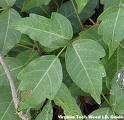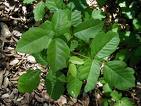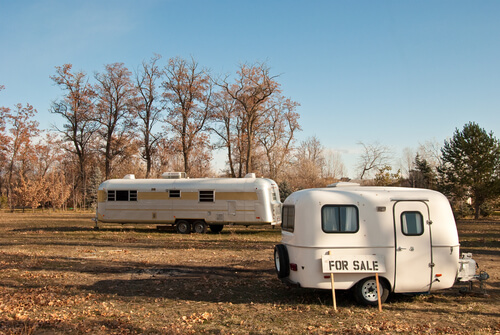Poisonous Plants
Poisonous plants saying - "Leaves of Three, Let Them Be" is one that has been around a long time.
That is a good thing to remember while camping. You will find many different species all through the campground or any wooded areas.
You will find poison ivy, poison oak and sumac growing on the ground or wrapped around trees. Poison Ivy tends to grow on a vine which spreads around the tree trunk area.
You can find it growing over the ground surface. DO NOT TOUCH IT!!
You will have an itchy rash develop on your skin within a short time.
This common poisonous plant has an oil that forms on the plant surface and when contacted, is brushed onto the skin.
This oil will form tiny blisters on the skin where touched.These blisters spread when scratched.
The best thing you can do is not scratch the affected area. It can be passed to other people if the oil is on the skin when contact is made.

Poison Oak and Sumac grow on small shrubs. These also have three leaves and is equally as toxic as the poison ivy. You will find these common poisonous plants in wooded and wet areas. These also cause itchy skin rashes that will spread if scratched.
The BAD news - You will have great discomfort and can get an itchy rash that develops from contact with any of these plants. It will spread to other skin areas if touched by the oil.
Swelling can occur at the affected area. These areas can also become tender or inflammed. Oozing or draining of the blisters may occur.
The GOOD news - You can reduce the swelling and inflammation with a topical corticosteroid such as hydrocortizone cream.
Anti-itch lotions can help, also. Upon contact with these plants, wash the affected area with warm, soapy water. Apply a topical steroid sparingly.
Do not rub or cover the affected area. You may not need to apply any kind of cream if you get to the soap and water quickly. Pat dry and do not rub the skin. Rubbing alcohol tends to help stop the spreading if used right after touching them.
Plants to AVOID
If you can’t clearly identify a plant and you don’t know if it’s poisonous, it’s better to be safe than sorry. Steer clear from a plant if it has:
- Milky or discolored sap
- Spines, fine hairs, or thorns
- Beans, bulbs, or seeds inside pods
- Bitter or soapy taste
- Dill, carrot, parsnip, or parsley-like foliage
- “Almond” scent in the woody parts and leaves
- Grain heads with pink, purplish, or black spurs
- Three-leaf growth pattern
The main three poisonous plants to avoid are the poison ivy, poison oak and the poison sumac. These are found in wooded areas, which means, yes, at the campground.
These like to crawl up tree trunks, bush the ground and grow over walkways and trails. You can spot them by looking at the leaves.
They all have 3 leaves together. First, let's look at:
Common Poisonous Plants

Poison Ivy is plentiful in the woods. You don't have to even look for it for it to find you. This poisonous plant can cause blisters on your skin surface.
It grows all year long and has no climate preference. It doesn't care how old you are or what you look like. It is poisonous to everyone.
The most important thing to remember is not to touch it. It can give your skin blisters everywhere it comes in contact. If you are not around soap and water, use some hand sanitizer. Wash with warm, soapy water when you can.
The next poisonous plant to cover is Poison Oak.

This also is highly contagous. DO NOT TOUCH this plant! It is also a blistering plant much like it's sister poison ivy.
You will find the same results in both plants. The treatment is the same, wash you hands and arms with warm, soapy water. It will help to have some itch relief lotion with you. It seems to be a year round thriving plant.
You will see it in wooded areas. Of course, you know the campgrounds are full of woods. Therefore, you can expect to see it covering the ground and climbing trees.
The third one is poison sumac

It, too, is found in the wooded areas and is likely to cause skin blisters. You will see it growing up tree trunks and as ground cover.
DO NOT TOUCH it! I can't stress it enough. You can look at it and it won't get on you, but touching it is the NO-NO part of walking around the campground.
The last one I want to cover is mushrooms:

There are so many different poisonous mushrooms. You will find them growing wildly in all wooded areas.
They grow from the ground, on tree trunks, on dead wood, in grassy areas and even in rocky areas. Do not touch any type of mushroom! They could be poisonous.
Children should be warned to stay away from them. Some are very colorful and look like something nice to pick for Mom, but they are potentially poisonous.
Some may look oddly shaped and that is also an attention grabber. Removing them from their attachment may release some powder of which is poisonous.
Mushrooms can be looked at and photographed, but don't get close enough to touch it.
If you suspect someone has eaten a poisonous mushroom, gather any remaining pieces and put them in a sealed bag.
Take it with you to the doctor's office or emergency room.
If the person has only eaten a small bite out of it, bring the rest of the mushroom.
If he has eaten a number of them, gather mushrooms from the same area for a determination to be made by the physician.
A beautiful wildflower may be the focal point of a child's attention to pick for Mom, but that very same flower may put that innocent child in danger of handling a common poisonous plant.
Get informed to poisonous plants that grow around campgrounds and watery areas.
Show the plants to your children and explain to them the dangers of picking them or even being around them.
Make sure you keep some kind of book in your camper on the different kinds of plants and flowers to stay away from. A book on the ways to treat your skin if you do come in contact with them will be most helpful.
Also see Safe Hiking Trails
- Home
- Camping Safety
- Poisonous Plants



